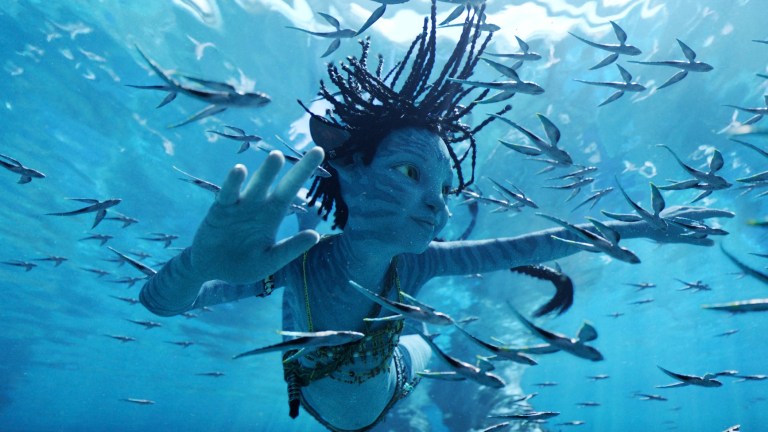How Avatar: The Way of Water Filmed Three Sequels at Once
Avatar became famous for its revolutionary filmmaking technology, but as its first epic sequel approaches cinema, we learn there’s more to it than expensive CGI.

This article appears in the next issue of DEN OF GEEK magazine. SUBSCRIBE HERE!
It’s no surprise that the sequel to Avatar is going to have mind-blowing visuals, but when the script for Avatar: The Way of Water was complete, even the movie’s producer had doubts about their ability to film it.
“When we first started developing the script, we really tried to do it without thinking about the ‘how,’ right?” says Jon Landau, the producer of Avatar and its sequels, in an interview with Den of Geek magazine.
Once the script was done, Landau’s reaction was, “Oh my gosh, how do we do this?”
In case the scope of that project wasn’t enough, the crew wasn’t just shooting one Avatar sequel but two whole movies and the first act of the fourth one. It was an epic undertaking, but combining the shoot across nearly three films also had its advantages.
“It’s like making one long miniseries, and there are great production advantages to doing it that way,” says Landau. “If we have a scene that takes place in John’s office in movies two, three, and four, we can go pre-light John’s office once, shoot it once and strike out of it once. If we did it as three movies, we’d pre-light it three times.”
More Than Skin Deep
Avatar made a big splash in 2009 with the level of technology it used for motion capture and filming in 3D. The Way of Water built on that—most noticeably in its pioneering underwater motion capture techniques, but as Landau points out, the actors’ performances were at the center of everything.
“It starts with the closeup. If you don’t find the characters compelling, it doesn’t matter what technology you throw at them,” Landau insists. “So we said, let’s make the fidelity of our performances even better than they were in the first movie.”
Instead of recording actors’ faces with one high-definition camera, they would use two. Then, using technologies like deep learning, effects firm Wētā FX delved deeper into understanding what the actors were doing.
“They don’t drive a performance from the skin on the outside,” Landau says. “They drive a performance from the muscles on the inside.”
Beyond Pixels
While Avatar is a franchise heavily associated with motion capture and green screen, more traditional filmmaking techniques weren’t abandoned.
“We had more physical sets on the sequel than we had on the first movie,” says Landau.
The production took over Stonestreet Studios and another 250,000-square-foot facility filled with sets, as well as additional locations in Auckland.
“Our sets are big, and we have an incredible design team that does those,” Landau says. “Brendan Cowell, who’s the captain of the Sea Dragon, was on a 60-foot boat on a motion base, and it was real, it was tactile.”
But whether on a motion capture stage (called a “Volume”) or a physical set, it was the actors that drove the story.
“A moment between Bailey Bass and Kate Winslet sort of sums it up,” says Landau. “The young actors were a little bit nervous about Kate Winslet coming in. Kate knew of Bailey, and the minute she saw Bailey, she said something to the effect of, ‘Come give your mother a hug,’ because she plays her mother. We talk about the Avatar family. It’s a movie about family, but we are a family.”
Avatar: The Way of Water opens Dec. 16.
